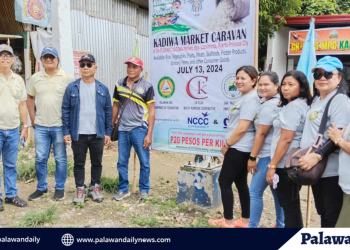Few days before the end of 2019, the Bureau of Fisheries and Aquatic Resources (BFAR) has issued its latest Shellfish Bulletin No. 26 yesterday, December 27, 2019, identifying eight sites in the country found to be positive for paralytic shellfish poison, including Puerto Princesa Bay.
The bulletin is based on the latest laboratory results of the BFAR and the local government units concerned of the shellfishes collected from the coastal waters of Bataan that covers nine coastal towns, coastal waters of Dauis and Tagbilaran in Bohol, four bays in both Western and Eastern Samar, Cancabato Bay that include the Tacloban City in Leyte, Lianga Bay in Surigao del Sur and Puerto Princesa Bay in Puerto Princesa City.
The Shellfish Bulletin advised the public not to harvest, sell, buy and eat shellfishes in the identified areas found to be positive of paralytic shellfish poison or red tide.
“All types of shellfish and Acetes species or alamang gathered from the areas are not safe for human consumption provided that they are fresh and wash thoroughly, and internal organs such as gills and intestines are removed before cooking,” Undersecretary for Fisheries and Director of BFAR, Commodore Eduardo B. Gongona said in the statement.
This year, Puerto Princesa Bay was not included in the Shellfish Bulletin only during the months of February, March and April, however, on May 2019, it was included in the BFAR Shellfish Bulletin that banned the harvesting, selling, buying and eating shellfishes from the bay.
Aquaculturist Joven Delgado of the City Agriculture’s Office said that the red tide is caused by organisms called dinoflagellates that multiply in the seawater, which is now called as Harmful Algal Bloom (HAB).
He further explained that this small organism known as dinoflagellates can only be seen through a microscope. It is similar to a plant which will bloom if there are plenty of nutrients. He said that after a long dry season which was followed by rains five months ago, or last July, there are surface water runoff from the upland that drains towards our water bodies, particularly in the seawater.
“Ang sobrang pagdami ng sustansya sa tubig, particular ang nitrate at phosphate ay maaring sanhi ng paglitaw ng red tide o pagkakaroon ng HAB,” Delgado explained.
Other factors that contribute to the increase of the population of the organism are low salinity of seawater and high surface temperature of seawater and dirty water that is drained towards the sea.
Delgado explained that as a protocol, if a specific area is declared as positive of red tide toxin like in the case of Puerto Princesa Bay, a weekly test and sampling is conducted. It is only until three negative results from red tide toxins, when the shellfish ban will be lifted and the affected area will then be declared as free from red tide.




















Discussion about this post